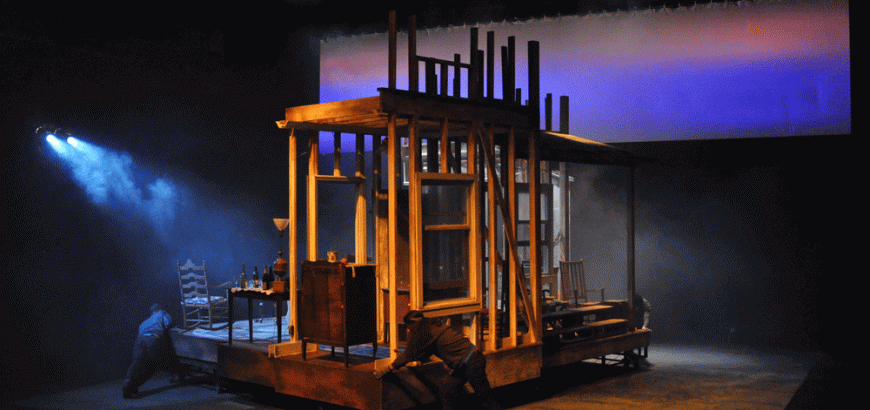Second-year Scenic Design MFA candidate Jared Roberts knows the importance of understanding how actors move through space. During his undergraduate studies, he would design a show, paint it, light it, and act in it. “I think it’s really critical that I got to experience the overall arc of a production.” He took that knowledge and applied it to the design for the production of Fifth of July, which ran last November. Here, Jared gives us insight into the process and big ideas that brought his vision to the stage.
What about Fifth of July made it an exciting play to design for?
It’s straight forward and real. Everything is out on the table. I try to let the script show me how to design for the show versus the time period. I wouldn’t approach it any differently if the script is set two weeks ago or 200 years ago. I’d ask the same questions. Who are the characters? Why produce this show here and now?
What was the process for designing the set for Fifth of July?
Val [Director and Professor Valerie Curtis-Newton] had a couple of driving forces in mind. The question driving everything was: What do you do when the fireworks are over? Then, there was the idea that all the characters escaped their everyday lives to come back to this particular place, but once they arrive they become trapped by their relationships to each other. The house had to have a sense of specific memories. It had to be nostalgic. It also needed to trap the characters in a confined space.
To the first meeting, I brought sketches and research images of houses from the 1970s. We talked about how the characters may move through the space. How will they interact with each other? I often draw artist reactions to the script – initial sketches that I may never show to anybody.
Was there an “ah-ha” moment for putting the set on wheels?
We wanted all the space to be one space – one location. We can see the characters doing things on both sides. We talked about ways to accomplish that and what we came up with was changing the audience’s perspective.
What challenges did Fifth of July present? Were there any unexpected, but happy accidents?
The primary challenge was answering the question: How do we get from Act I to Act II? The script describes a sunroom and a porch. How do we get there?
The final design ended up being skeletal. We had planned on a surface, but a translucent one so you could see the studs and there would be the allusion of seeing through the walls. The surface detail got cut because of time and budget, and that ended up being a happy accident. Looking back, with more time and money, I wouldn’t have changed anything. I’m glad we were restricted.
What first got you interested in scenic design?
I enjoyed acting in high school and I thought I’d do theatre for a year while I decided what I really wanted to do. One day, a directing professor pulled me aside and showed me some random pictures, asking me what I thought about them. She was testing my design eye. I designed a show freshman year in college and fell in love with it.
I acted a few times in undergrad. I did it all. I would design a show, paint it, light it, and act in it. I think that’s really critical – that I got to experience the overall arc of a production. It’s important to have had the acting experience, to understand how actors move through space and interact with things.
What was the first year of the program at UW like?
I came in knowing the program would be difficult, but I had no idea how completely immersive it would be, and how that would challenge me. We design for three theoretical shows at a time. Designing for theoretical productions allows you to try anything. You get to experiment and explore what you otherwise might not be able to do. Each professor pushes me in a different way. Each one is about helping me figure out “What is the best thing I can do?” The professors are focused on helping me visualize my version of the show; helping me define my language.


